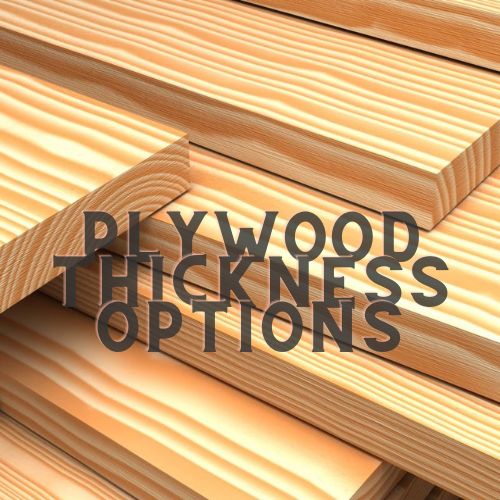Introduction
Plywood is a versatile and commonly used building material that can be found in a wide range of construction and woodworking projects. One crucial aspect to consider when working with plywood is its thickness, as it directly impacts the structural integrity and suitability of the material for various applications. In this comprehensive guide, “Plywood Thickness Options,” we will explore the different thicknesses available, their uses, and how to make informed decisions to ensure the success of your projects.

Understanding Plywood Thickness
Before we dive into the various thickness options, it’s essential to understand how plywood thickness is measured. Plywood thickness is typically measured in millimeters (mm) or inches (in), and it refers to the thickness of the plywood panel itself, excluding any veneer or laminate layers.
Common Plywood Thickness Options
Plywood is available in a range of thicknesses, and each thickness has specific advantages and best-suited applications. Let’s explore the most common plywood thickness options:
1. 1/4-inch Plywood (6mm)
- Description: This is the thinnest plywood option and is often referred to as “quarter-inch” plywood. It is lightweight and flexible.
- Common Uses: 1/4-inch plywood is suitable for interior paneling, cabinet backs, and craft projects where a lightweight material is desired.
2. 3/8-inch Plywood (9mm)
- Description: 3/8-inch plywood offers more stability and strength than 1/4-inch plywood. It is still relatively thin but more substantial.
- Common Uses: It is used for cabinet construction, furniture backing, and wall sheathing.
3. 1/2-inch Plywood (12mm)
- Description: 1/2-inch plywood is one of the most commonly used thicknesses. It strikes a balance between strength and flexibility.
- Common Uses: It is suitable for subflooring, wall and roof sheathing, and many furniture and cabinetry applications.
4. 3/4-inch Plywood (18mm)
- Description: 3/4-inch plywood is a thicker and more robust option, known for its durability and stability.
- Common Uses: It is used for heavy-duty applications such as flooring, furniture construction, and structural components.
5. 1-inch Plywood (25mm)
- Description: 1-inch plywood is the thickest option available and provides exceptional strength and stability.
- Common Uses: It is used in demanding structural applications, including marine and industrial settings.
Long-Tail Queries Related to “Plywood Thickness Options”
- When should I choose 1/4-inch plywood for my project?
- 1/4-inch plywood is ideal for lightweight interior applications and crafts.
- What is the difference between 1/2-inch and 3/4-inch plywood in terms of strength?
- 3/4-inch plywood is thicker and offers greater strength and stability compared to 1/2-inch plywood.
- Can I use 3/8-inch plywood for subflooring, or should I opt for 1/2-inch plywood?
- While 3/8-inch plywood can be used for subflooring, 1/2-inch plywood is a more common choice for added durability.
- Is 1-inch plywood suitable for outdoor use?
- 1-inch plywood can be used outdoors but is often reserved for heavy-duty industrial or marine applications.
- What are the considerations when choosing plywood thickness for cabinet construction?
- The choice of plywood thickness for cabinets depends on the design and desired sturdiness. 1/2-inch or 3/4-inch plywood is commonly used.
FAQs
Q1. How do I determine the right plywood thickness for my project?
Choosing the right plywood thickness depends on factors like the project’s intended use, load-bearing requirements, and design specifications. Thicker plywood is generally stronger but heavier.
Q2. Can I use thinner plywood for subflooring?
While thinner plywood like 3/8-inch can be used for subflooring, it’s essential to ensure that it meets local building codes and provides adequate structural support.
Q3. Are there specialty plywood thickness options for specific applications?
Yes, some specialty plywood thickness options are designed for unique applications, such as marine plywood for boat construction and aircraft plywood for aviation projects.
Conclusion
Selecting the right plywood thickness is a crucial decision when planning any construction or woodworking project. Each thickness option offers distinct advantages and is suited to particular applications. Whether you’re working on a lightweight craft project or a heavy-duty structural endeavor, understanding the plywood thickness options available and their appropriate uses will help you make informed decisions, ensuring the success and longevity of your projects.
Not Sure What Are You Looking At? Check the below guides:
What are the benefits of engineered wood flooring
Benefits of Linseed oil on wood
